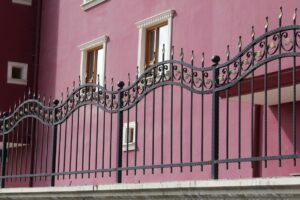
When you’re looking for new metal fencing, two of your choices are going to be wrought iron and ornamental iron fencing.
When you’re looking for new metal fencing, two of your choices are going to be wrought iron and ornamental iron fencing. But since they’re so similar to one another, you might not be able to tell them apart. So you walk away scratching your head and wonder, what’s the difference between wrought and ornamental iron? Here is a secret: these are two names for the same type of metal.
Wrought Iron is Handmade
Wrought iron refers to worked iron or the metal that is hammered and shaped by blacksmiths. Although you might hear the word blacksmith and instantly think of swords, shields, and axes crafted in TV shows, movies, and video games, blacksmiths also created other things, such as horseshoes and the first wrought iron fences. The blacksmith’s forge was one of the most important tools any blacksmith could use because it was the heating element used to shape the metal until it could be hammered together. Handmade wrought iron is distinguishable by odd dents and bends that indicate it was formed by human hands and not machine processes.
Different Methods
One example of a machine process is called bent work. Bent work was a dismissive name given to wrought iron products that were not made by a blacksmith toiling at a forge. The main difference in these techniques is that strips or bars of iron are cut apart and heated before being bent. Arc welders fuse the pieces of iron together, which means that a blacksmith’s forge is no longer part of the process.
The Presence of Carbon
One last difference between wrought iron and ornamental iron is how much carbon the metal contains. Blacksmiths and ironworkers used to use low-carbon metal to create wrought iron; this wrought only had about 0.04% of carbon in it. Today, that has been mostly replaced by a substance known as mild steel. Mild steel still has a small amount of carbon in it, but its content increases to either 0.2 or 0.6% – because of this, the original method is using low-carbon metal is dying out and is even harder to track down if you would like to use that for your wrought iron fence.
CHOOSE HERCULES CUSTOM IRON FOR HIGH-QUALITY FENCING SERVICES
If you know what kind of iron fences and gates you want to install, or if you still have questions, trust Hercules Custom Iron! We have years and years of experience, and we will make sure that your new wrought iron fence will serve you as long as you reside in your home. If you have questions, you can visit us online or give us a call at 1-800-331-2590. For updates on our latest projects, be sure to follow us on Facebook, Twitter, LinkedIn, YouTube, Google+, and Pinterest.

